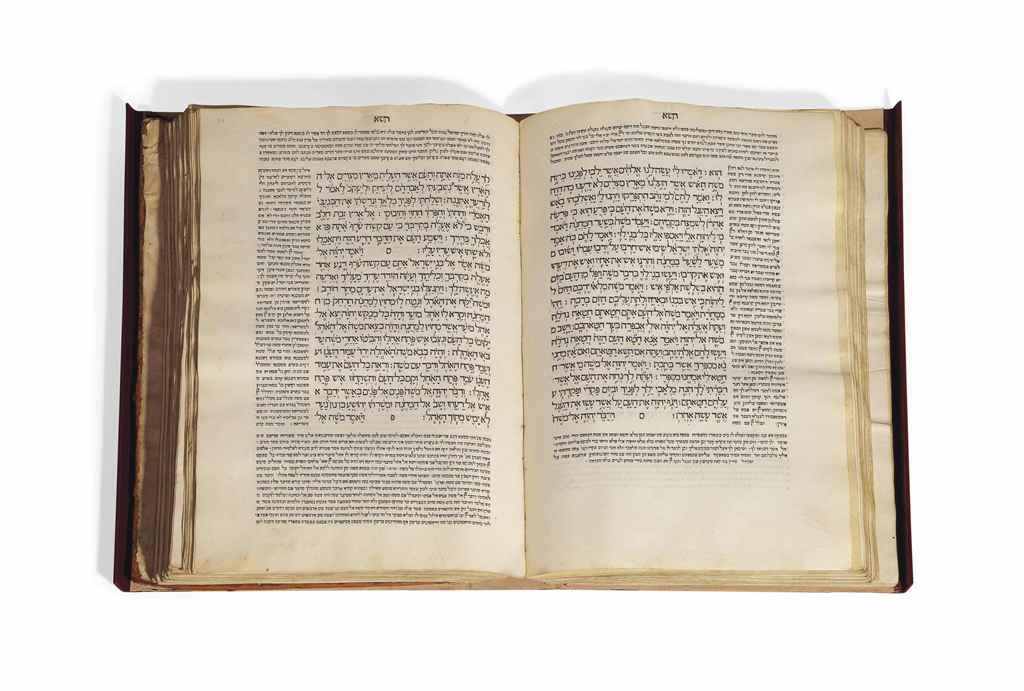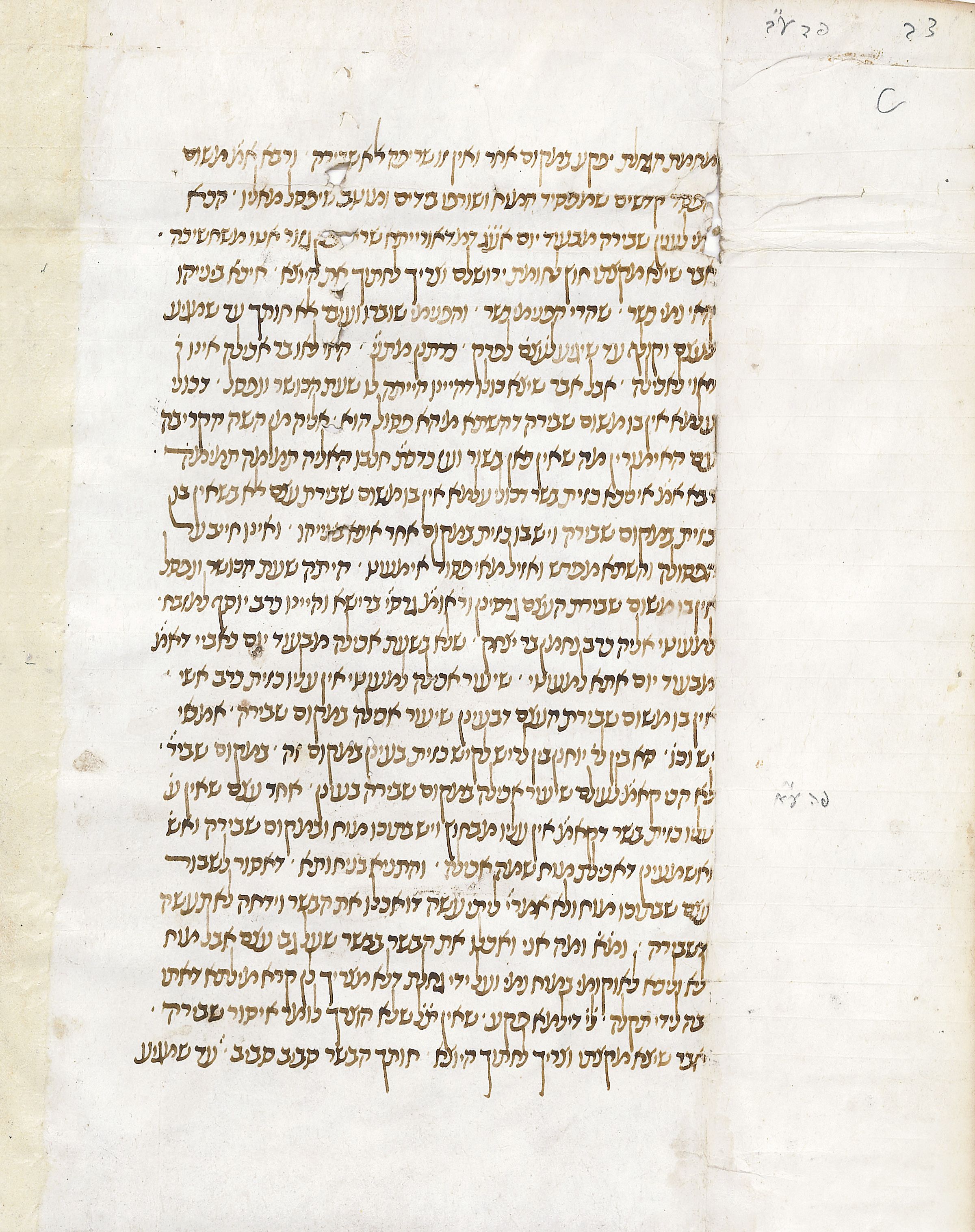RASHI, Solomon ben Isaac (1040-1105). Commentary on the Prophets (II Samuel 22:1 to Zechariah 6:13), in Hebrew, MANUSCRIPT ON VELLUM [northern France, c.1200] 297 x 263mm. 122 leaves: 1-2 8, 3 8 + 2(2 leaves, pp.43-46, a slightly later insertion after v), 4-11 8, 12 8(of 10, lacking viii, and x a final cancelled blank), 13-15 8, lacking several gatherings at the beginning and one at the end, modern pencil pagination followed here, two columns of 35 lines written in a Franco-Ashkenazic semi-cursive script with aleph-lamed ligature, a few headings and concluding lines in Franco-Ashkenazic square script, tetragrammaton written as double or triple yod with an additional pen stroke, all in dark brown ink between four verticals and 36 horizontals ruled in blind, justification: 85-17-85mm, upper margin 26mm, lower margin 44mm, inner margin 38mm, outer margin 38mm, ten lines 85mm, catchwords in the lower margin of final versos with decoration (probably slightly later) that is sometimes elaborate and figural, as pp.84, 212 and 196, the latter with a deer and a hybrid figure and protruding into the text area, line-filling usually by anticipating the first letter(s) of the next word in the line, including the use of broken mem, shin, ayin as on p.96, the use of dilated letters or the use of a graphic filler slightly resembling a cursive het, a thick rounded horizontal stroke and a thinner vertical stroke on the left, protruding lines generally prevented by compressing last words or by abbreviating words towards the end of the line, with a single abbreviation accent, occasionally one or two letters do protrude into the margin, diagrams of the Temple and of the Temple Mount in Ezekiel (first gathering detached, original marginal holes and stitching, some tears and patches in margins and occasionally in text with slight losses, cropping resulting in the probable loss of two catchwords from quires 3 and 12, where only decoration remains, modern repair to marginal tear of pp.41/42, darkening and wear towards the end of the manuscript and no more than half of the final four leaves surviving). Nineteenth-century half-leather, one paper endleaf at back, yellow edges, there are sewing stations from at least one earlier binding (severely rubbed, boards detached, spine rubbed and defective). Modern black cloth box. PROVENANCE: 1. Professor Malachi Beit-Arié has examined the manuscript and confirmed that the vellum was prepared in the manner traditional for Ashkenazic Hebrew manuscripts, specifically for codices produced in France, until the middle of the 13th century. There is a marked difference between flesh and hair sides, unlike parchment prepared later which has indistinguishable or nearly indistinguishable sides, and this difference between hair and flesh is reflected in the arrangement of the sheets according to Gregory's rule, that hair side faces hair side and flesh side faces flesh side. Among the old Ashkenazic manuscripts that display such distinguishable skin sides, there is not a single example that can be attributed with any certainty to Germany, whereas there are several extant manuscripts of this type that bear explicit or implicit proof of being written in France. The parchment leaves were gathered in quires of four bifolia, as is the case for almost all Ashkenazic manuscripts. It is ruled in the manner prevalent in such manuscripts only until the middle of the 13th century: vertical rows of prickings were made in the outer margins only and the lines were drawn by hard-point on the hair sides of the unfolded bifolia. The script of the codex, and comparison of its writing to early Ashkenazic manuscripts enables us to identify the time and region of its production more precisely. The commentary is written in a pre-Gothic semi-cursive Ashkenazic type of script that developed in the second half of the 12th century. Among explicitly dated manuscripts no example survives from before 1226/7 (Oxford, Bodleian Library, Laud. 271). The
RASHI, Solomon ben Isaac (1040-1105). Commentary on the Prophets (II Samuel 22:1 to Zechariah 6:13), in Hebrew, MANUSCRIPT ON VELLUM [northern France, c.1200] 297 x 263mm. 122 leaves: 1-2 8, 3 8 + 2(2 leaves, pp.43-46, a slightly later insertion after v), 4-11 8, 12 8(of 10, lacking viii, and x a final cancelled blank), 13-15 8, lacking several gatherings at the beginning and one at the end, modern pencil pagination followed here, two columns of 35 lines written in a Franco-Ashkenazic semi-cursive script with aleph-lamed ligature, a few headings and concluding lines in Franco-Ashkenazic square script, tetragrammaton written as double or triple yod with an additional pen stroke, all in dark brown ink between four verticals and 36 horizontals ruled in blind, justification: 85-17-85mm, upper margin 26mm, lower margin 44mm, inner margin 38mm, outer margin 38mm, ten lines 85mm, catchwords in the lower margin of final versos with decoration (probably slightly later) that is sometimes elaborate and figural, as pp.84, 212 and 196, the latter with a deer and a hybrid figure and protruding into the text area, line-filling usually by anticipating the first letter(s) of the next word in the line, including the use of broken mem, shin, ayin as on p.96, the use of dilated letters or the use of a graphic filler slightly resembling a cursive het, a thick rounded horizontal stroke and a thinner vertical stroke on the left, protruding lines generally prevented by compressing last words or by abbreviating words towards the end of the line, with a single abbreviation accent, occasionally one or two letters do protrude into the margin, diagrams of the Temple and of the Temple Mount in Ezekiel (first gathering detached, original marginal holes and stitching, some tears and patches in margins and occasionally in text with slight losses, cropping resulting in the probable loss of two catchwords from quires 3 and 12, where only decoration remains, modern repair to marginal tear of pp.41/42, darkening and wear towards the end of the manuscript and no more than half of the final four leaves surviving). Nineteenth-century half-leather, one paper endleaf at back, yellow edges, there are sewing stations from at least one earlier binding (severely rubbed, boards detached, spine rubbed and defective). Modern black cloth box. PROVENANCE: 1. Professor Malachi Beit-Arié has examined the manuscript and confirmed that the vellum was prepared in the manner traditional for Ashkenazic Hebrew manuscripts, specifically for codices produced in France, until the middle of the 13th century. There is a marked difference between flesh and hair sides, unlike parchment prepared later which has indistinguishable or nearly indistinguishable sides, and this difference between hair and flesh is reflected in the arrangement of the sheets according to Gregory's rule, that hair side faces hair side and flesh side faces flesh side. Among the old Ashkenazic manuscripts that display such distinguishable skin sides, there is not a single example that can be attributed with any certainty to Germany, whereas there are several extant manuscripts of this type that bear explicit or implicit proof of being written in France. The parchment leaves were gathered in quires of four bifolia, as is the case for almost all Ashkenazic manuscripts. It is ruled in the manner prevalent in such manuscripts only until the middle of the 13th century: vertical rows of prickings were made in the outer margins only and the lines were drawn by hard-point on the hair sides of the unfolded bifolia. The script of the codex, and comparison of its writing to early Ashkenazic manuscripts enables us to identify the time and region of its production more precisely. The commentary is written in a pre-Gothic semi-cursive Ashkenazic type of script that developed in the second half of the 12th century. Among explicitly dated manuscripts no example survives from before 1226/7 (Oxford, Bodleian Library, Laud. 271). The













Try LotSearch and its premium features for 7 days - without any costs!
Be notified automatically about new items in upcoming auctions.
Create an alert